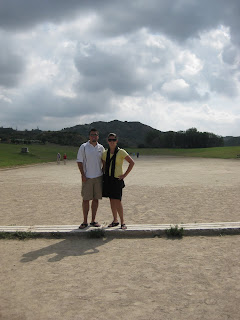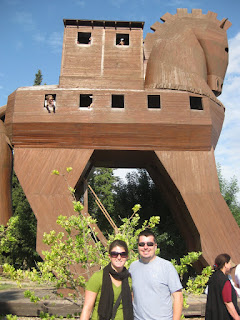
Monday, June 28th, 2010
This morning we left the hotel around 10:00 a.m. Our agenda for the day was to see the Mozart museums in the morning and then tour Schloss Hellbrunn in the afternoon. We went first to Mozart’s Wohnhaus or residence. Mozart lived in Salzburg until 1780, when he was 24 years of age, and it was this location where he lived with his parents and sister for the later part of his years in Salzburg. Again, we were not allowed to take photographs in the museum, but I will tell you a couple of things regarding the museum. First of all, I managed to resist the urge to touch Mozart’s harpsichord unlike my father and thus avoided scolding (thanks for the warning Mom). Secondly, my favorite pieces were the whimsical targets, over which Mozart and his father competed to come up with the most hysterical scenes to portray on the targets, and let’s just say there were some funny ones. From Mozart’s Wohnhaus we made our way over to Mozart’s Geburtshaus, or birthplace, where he, his parents, and his sister spent their earlier years in Salzburg. Here I learned some interesting things about Mozart and his family. Mozart may have lived in Salzburg until he was 24, but he spent almost a third of his life traveling, 3720 days to be exact, and his 35 years he composed 600 works, 22 of which were operas. Interestingly enough, Mozart considered himself to be primarily a composer of operas. Mozart worked with the best singers of his time, but they were often difficult, not much different from the famous actors of today. The audiences of the 18th century however were very different from those of today. Audiences typically would talk, receive guests, and even eat food throughout the 6 to 8 hour performances. Principals about medicine were also unique in those days. The Mozart family supposedly washed daily, which was uncommon in the 18th century, as most people still believed that water if applied externally caused diseases. The primary medicines of the day were primarily laxatives, as it was believed that illnesses must be excreted from the body, which is also the reasoning for frequent blood-lettings of the day.
After touring the Mozart museums we walked over to a plaza, which was said to have fast food stands based on what our guidebook stated. We found the plaza, and sure enough it was filled with Würstelstands and fruit vendors and more. For lunch Tim had a bürenwurst and I had a käsekrainer, and they were delicious. After finishing our lunch we bought some fruit to have for a snack and for breakfast in the morning as well as a “Salzburger Brezen” or pretzel, which was very unique in that it had a very strong fennel taste to it. After lunch we walked back to the hotel to have a short rest.
After a rest we headed to the train station to pick up a bus to take us to Schloss Hellbrunn. It was a short bus ride out to the Palace. When we arrived we first headed to do a guided tour of Schloss Hellbrunn’s famous trick fountains. The most famous of these is the Prince’s table. At the Prince’s table, the Archbishop who built the castle and its trick fountains 400 years ago would seat his guests and enjoy a meal together, but when he gave the signal, one of his servants would flip a switch and suddenly water would come gushing out of the guests seats and from around the table, drenching them all. This was particularly funny because there were very strict court rules which stated that no one may stand before the archbishop, and of course his seat was completely dry. Other trick fountains included a “rain grotto” in which the archbishop would entertain his guests and again at the flip of a switch rain would pour down upon them. There are also little “Disney-like” scenes along the walkways depicting various Greek Mythology with moving characters as well as a large stage with multiple levels that plays music and you can watch the characters move about the town and at the end on-lookers get a surprise in the way of a blast of water from behind. The amazing thing about all of these contraptions is that they are all water powered, as there was no electricity back in those days. After touring the trick fountains we took a quick tour of the interior of the Palace before walking back to the bus stop and catching a ride back in to town.
Once back in town we headed back to the hotel once again to rest and clean up for dinner. For dinner we walked back down into the “Old Town” to a restaurant called Wilder Mann, which was recommended in our guidebook. The food was good and drinks were cheap, and we ended our meal with a desert that didn’t taste like wet dog smells this time, a pancake filled with ice cream and covered with chocolate sauce….YUM!
Tomorrow we have a long travel day as we head to Switzerland. We had to switch our order up a bit because of accommodations, so we will be taking the 6:00 train to Zurich, catching the 11:35 train to Luzern, and then the 12:55 train to Interlaken. We should be at our destination by around 3:00 in the afternoon, so for now. Goodnight!






















